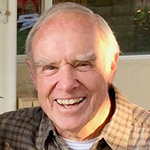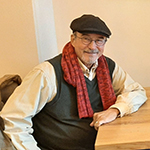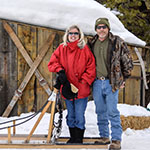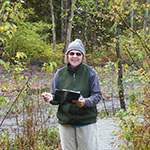Milestones & New Members
3/7/2023Leave a Comment
40 YEARS+
San Diego Chapter

Roger DeWeese, FASLA
Where are you from and how long have you been a landscape architect? It has been about fifty years since I first joined ASLA and I am proud of the ever-increasing respect that the Society has been able to achieve during that time. There were a lot of public misconceptions that needed clarifying in the Society’s formative years. Were Landscape Architects some kind of special gardeners, horticulturists, contractors or what? The public didn’t seem to know. I didn’t even know the answer when I transferred out of engineering and into Landscape Architecture after four years of studying Mechanical and Industrial Engineering. All I knew was that I wanted to do something more creative, and I loved the outdoors. I was born and raised in California, so I was thoroughly indoctrinated into most outdoor sports and activities. I must admit that I was not terrific at anything but as a generalist I learned a lot and had a lot of fun. How did you begin your career journey in Landscape architecture? I ended up attending four different colleges while trying to make my mind up about my future. Oregon State was the third college I attended. I went to their counseling office and took all their interest and aptitude tests. They said that my problem was that I was interested in too many things. I note here that interest is unfortunately not necessarily related to one’s ability. The counselors gave me a book about Landscape Architecture and wished me luck. Looking back, it was a good choice that combined my interests, experience, and my engineering background. I observed that too many people were going into Landscape Architecture that had wanted to be architects, but they could not handle the math requirements, and they assumed that Landscape Architecture would be easier (not realizing that math is essential to just about all professions). What would you share with those new to the profession of landscape architecture? For people and students that are new to the profession I would suggest that, if possible, they get a part time job or summer job at a landscape architect’s office. If they are going to be respected in the field (and that IS important), get a job with a landscape contractor for a year or two. Go to nurseries and botanical gardens a lot. Make a collection of plant identification photos and plant books. Go to trade shows and get familiar with irrigation equipment. Pay attention to contracts and agreements and use what might be appropriate for your type of services. Also pay attention to the classes in college that you may hate because they may be the ones that will be the most useful to you (trust me on this one). Experience a diversity of jobs that may help you realize what you do not want to do for a living. What in your view is the most important thing that landscape architects provide? Our profession brings, or should bring, the big picture to any project. Landscape architects see opportunities that others miss if brought into the design team early enough. To get an opportunity like that one must have a client that respects your abilities. Thinking outside the box, and outside the profession, is often appreciated by good clients.
40 YEARS+
Georgia Chapter

Ed Czyscon, FASLA
Where are you from and how long have you been a landscape architect? Originally from Central New York and I grew up in the Adirondacks of Northern New York as my playground. Growing up in the 1960's with the Environmental Movement growing, I decided to go to college for Forestry. After receiving a Forestry degree in 1971 from Paul Smith's College, I wanted to explore designing with nature and continued my education at Syracuse SUNY ESF in Landscape Architecture. I have been practicing Landscape Architecture for over 47 years. How did you begin your career journey in Landscape architecture? I began my LA career designing and master planning parks for the City of Orlando Parks Department in 1976. My LA career then took me to Tampa working for an engineering firm designing parks, master planning new communities and office parks. Then one day in 1981 with a planner and an engineer friend we started a new company. Over 8 years our multi-disciplined firm (FLD&E) grew to over 200 employees and 7 offices throughout Florida. Our focus was large scale Multi-Use developments ( Harbour Island, Hunters Green, Fishhawk Ranch), Park systems (Pasco County's 12 Park system, Canaveral National Seashore , Six Mile Cypress Slough, Munn Park), Office Parks and DRI's. We sold our firm in 1989 to an International design firm and I started working on international projects in Dubai, Haiti, Guam. In 1998, I moved to Atlanta and managed an office for a multi-disciplined design firm. Our work was primarily on public projects in Georgia, North Carolina and South Carolina. Over the last 6 years of my career I worked as a Program Manager overseeing the designs and construction of Cobb County Parks 160 million Parks developments. I have since retired living in the North Georgia Mountains area with my Fiber Artist wife Robyn. What do you think is the most important issue facing landscape architects today? Problem solving! In any design there will be problems. Physical site problems, Political problems, Social problems. The key is to understand these problems, view them outside of your personal beliefs and try to solve the problems with help from others. What have you gained by being a member of ASLA for 43 years? Leadership!!! ASLA taught me how to be a leader....a leader in a Design team, a leader in Program Management, a leader in ASLA. My ASLA experience from a Section Leader to Chapter President, to Trustee to National Vice President helped me personally and professionally grow. What would you share with others as a reason for belonging to ASLA as a member? Get involved....in your local politics, your firm....and get involved in ASLA! What would you share with those new to the profession of landscape architecture? Be an Advocate for the profession of Landscape Architecture. Get involved in ASLA! Get involved in community Public Meetings. Get involved in speaking to legislatures on Lobby Day. What is your favorite project in your career and why? I would say there are 4 favorite projects. The first park I master planned and designed in Orlando , FL...Mayor Carl T. Langford Park. It was a small wooded park in a residential area with a stream meandering through it. The park was mainly a nature conservation preservation park with trails and boardwalks. The second project was the Deira Sea Corniche Master Plan in Dubai. It was a 3 year project working with other designers from various parts of the world. Living and working In-Country was an experience in itself. The third project has to be the Tampa Bay Office Park Waterscape project. This project was a stormwater management and aquatic waterscape design project in Tampa. It received numerous design awards including one at The White House. The fourth project is the Wilmington, NC Riverfront project. A 1 mile of riverfront walkway, boardwalk along the Cape Fear River. The Riverwalk has an assortment of restaurants, boutiques, art galleries all connected to the Riverwalk. What in your view is the most important thing that landscape architects provide? An Understanding of the design process and all the various aspects of a site analysis. Is there anything else you would like to share to commemorate your 43 years with ASLA? Be original and think positive!
40 YEARS+
North Carolina Chapter

Teresa Hawkins, ASLA
Where are you from and how long have you been a landscape architect? I was born and raised in Asheville, NC and graduated from North Carolina State University in Raleigh, NC with a BS in Landscape Horticulture and a Masters in Landscape Architecture. After serving as an apprentice landscape architect for 3 years, I became a registered landscape architect in 1982. I have worked in private practice for several firms in the Raleigh, NC area, then transitioned to public sector service with Orange County, NC and then the Charlotte Mecklenburg Planning Commission as an Urban Designer. I established a multi-disciplinary firm in Charlotte, NC, serving as President and CEO for 25 years. After the sale of my firm in 2006, I worked as a branch manager in Charlotte for the company that bought my firm. I have been a free lance landscape architect since 2009 working on a wide variety of projects. How did you begin your career journey in Landscape architecture? I was enrolled in the Landscape Horticultural program at NCSU as a freshman and was invited to supplement my degree program by taking Landscape Architectural design studio classes in the School of Design (now the College of Design). My studio professor was a practicing Landscape Architect named Linda Jewel, who encouraged and inspired me to become a Landscape Architect. Other Landscape Architectural program professors in the School of Design that also supported my interest and passion in Landscape Architecture and Land Planning. I was fascinated with learning the fundamentals of land planning and design, and enjoyed the numerous ‘real life’ landscape architectural projects presented to LA studio students by the dedicated professors at the School of Design. What do you think is the most important issue facing landscape architects today? I think the most important issue facing landscape architects today is keeping the practice of landscape architecture relevant within the larger design community and the ability to recruit new students into the accredited Landscape Architecture programs at the university level. The practice of Landscape Architecture needs a continual stream of creative and forward thinking young people, that can only be achieved by presenting the profession of Landscape Architecture as a path to a rewarding and successful long term career. I have often been dismayed that the majority of the general public (and even some clients) do not understand what a landscape architect actually does. Many think that a landscape architect is similar to a landscape contractor with an emphasis of projects limited to landscape planting design. ASLA should help promote, and clearly establish a message to the public at large, the wide variety of services provided by a landscape architect. What have you gained by being a member of ASLA for 40 years? When I initially joined ASLA as a student, the Society gave me a level of professional credentials and also opened my eyes to all of the opportunities that the field of Landscape Architecture has to offer. As I gained experience in the profession, ASLA gave me a support system from others in the profession and a great way to network and gain knowledge from all types of aspects of the profession. ASLA has always been a great resource for case studies, technology and design solutions that I have greatly benefited from. During my 25 years leading a multi-disciplined practice, I relied on ASLA to provide me and my staff training opportunities through printed media and via seminars and symposiums. What would you share with others as a reason for belonging to ASLA as a member? As I mentioned, ASLA gives a great deal of credibility to the registered and practicing Landscape Architect. I still use ASLA for resources when I encounter a new design challenge. The monthly Landscape Architecture magazine keeps me up to date on the latest cutting edge design projects and technology. What would you share with those new to the profession of landscape architecture? I would encourage those new to the profession to explore all of the aspects and technical opportunities that the field of landscape architecture can offer. I gained experience by working in both the public and private sector which has allowed me to be involved with very different areas of the profession. I would advise aspiring landscape architects to be involved in the entire project, from conceptual design, to development of construction documents, to construction administration in order to understand how the design is implemented in the field. I realize that the production of a design project is largely realized via computer, but I would encourage that all landscape architecture students learn how to sketch a conceptual design and refine it by hand before turning to the computer to finalize the design. What is your favorite project in your career and why? Would you like to submit/share a picture of it? Most of my professional life as a landscape architect has been in association with a multi-disciplinary firm so in 40 plus years I have been fortunate to have provided design on a wide variety of projects in the private and public sectors. I think my favorite projects have been the several projects where I have provided urban design services on projects located in uptown Charlotte, NC and on the various streetscape projects that I was privileged to serve as the principal designer for the City of Charlotte as my client. What in your view is the most important thing that landscape architects provide? In my experience I think a landscape architect is able to provide creativity to the design process. Our profession is probably closest to the practice of civil engineering, but a landscape architect can take similar technical skills and add a high level of creativity to the design process and to the final design product. The profession of landscape architecture has always strived to design ‘with the land’ in an environmentally sound way. Is there anything else you would like to share to commemorate your 40 years with ASLA? I can’t believe that I have been a landscape architect for over 40 years. The profession has changed and evolved over the past 40 years but the fundamentals and skills required of a landscape architect are basically the same. The design process is still intact and that process can be adapted and applied to every type of project.
30 YEARS+
New York Chapter

Barbara Restaino, ASLA - Taking notes at Teatown Lake Reservation in Yorktown, Westchester Co. NY
Where are you from and how long have you been a landscape architect? I am originally from New Jersey but often moved from rural towns to large cities as my dad was pursuing his career as a city planner. I feel most at home here in the Catskill Mts. of upstate NY where I have been living and practicing for over 30 years. I also practice in the Hudson Valley which is intimately connected to the Catskills. My small town is at the edge of the watershed of the Hudson River and part of the NYC reservoir system with the Rondout Reservoir. When I received my LA license, I applied for ASLA membership at that time and remember meeting the only two landscape architects that existed in several surrounding counties for their sponsorship. Belonging to ASLA has kept me connected with other landscape architects and my profession. How did you begin your career journey in Landscape architecture? I was fortunate to be introduced to landscape architecture very early on. My family lived in Baltimore at the time, and one of my father’s colleagues, a landscape architect, lived on our block. I was fascinated by his garden with potted papyrus and exotic looking plants in a tiny beautifully designed backyard. Later we moved back to New Jersey to a contemporary house that my father was in the process of building. Sadly, he became seriously disabled. The landscape was unfinished and raw but an opportunity for me to learn while I experimented with plants, going to as many nurseries as I could and installing plants using a shovel and wheelbarrow. I also remember my mother and me taking my dad to the Guggenheim Museum in NYC for an outing since that was one of the only buildings without barriers where we could negotiate his wheelchair. That was before ADA and it has made me very conscious of how design can affect people’s quality of life. In addition, I am very grateful to my mother, who was a math teacher and avid citizen scientist, for teaching me an appreciation of insects and introducing me to native plants. When I began contemplating becoming a landscape architect it was also a time of growing awareness of environmentalism. Ian McHarg’s Design with Nature, and Rachel Carson’s Silent Spring were strong influences. In addition to nature, I had a strong love of art, especially contemporary sculpture and I entered Pratt Institute in Brooklyn, NY for my BFA. My sculpture was always related to landscape and I received a great background in design and materials. I often consider landscape architecture a form of sculpture, especially when working with grades. I worked as a studio artist for a short period but decided I wanted projects that involved being outside with plants, dirt, rocks, water, animals, people, and some meaningful parameters. I headed for Ithaca, NY where I spent the next few years working toward my MLA at Cornell. Being in the country again and around an incredible variety of plants at Cornell botanic gardens was just what I needed. Later, I did my apprenticeship working under the Town of Ithaca Engineer where I learned valuable nuts and bolts skills and later under the Westchester Co. Director of Parks, John Fava, ASLA. When I moved up here to the Catskills in the 1990’s, married and with two children, it was rough going. Where to start where there are no firms, and jobs were far and few between? I managed somehow to find a handful of wonderful clients with significant properties who allowed me to design their rural landscapes. At that time everything was drawn by hand on a drafting table. All that hand lettering! Now of course we do everything digitally and we have expanded the scope of projects. I am still working to improve and be a better landscape architect. What do you think is the most important issue facing landscape architects today? I think the most important issue for landscape architects is to be relevant, credible, and to be respected as the skilled professionals that we are. It is critical that we are perceived as the profession that can address the design, equity, and environmental problems of our day and be valuable team members with other design professionals. I believe it is more appropriate for landscape architects to lead design teams because of our broad synthesizing abilities, our design capabilities and knowledge of plants, soils, climate, and how people use sites. Our problems of today are problems of design including climate change. I am heartened that we have a new CEO and forceful advocate in Torey Carter-Conneen. I hope in the future that full membership to ASLA will require licensure, similar to AIA and ASCE. For too long the public has confused us with landscape designers. What have you gained by being a member of ASLA for 30 years? I have had the privilege of serving on the New York State Council of Landscape Architects for several years, a board composed of both New York chapters that reviewed laws pertaining to the practice of landscape architecture in New York State. We met with State legislators and the Department of Education chair who oversees LA licensure. We promoted policies or laws that would benefit the practice of landscape architecture or lobbied against policies or laws that would hurt our practice here in New York State. ASLA membership has also given me the opportunity to keep connected with colleagues, join PPN’s such as Women in Landscape Architecture, and keep abreast of developments in our field. It is also a place where I can refer young people who are interested in landscape architecture to find out more about our profession. What would you share with others as a reason for belonging to ASLA as a member? I think it is a critical time to join forces to promote and protect the profession. Young potential landscape architects need to be mentored and encouraged to continue on an often difficult path to licensure. They need the support of a vibrant organization. Right now, with new leadership, I think ASLA has a real chance to move the profession forward where it should be. It will take effort but if we have more participation and membership in ASLA, we can strengthen the profession. Visibility is also a problem and more outreach to the public needs to be done to let them know what a landscape architect is. I just saw a video by Tory Carter-Conneen and he is doing just that, but it needs to be done on all levels. We need to speak to people outside of the profession and get them really interested and excited. What would you share with those new to the profession of landscape architecture? Landscape architecture is an amazing profession that is inclusive of so many elements that need to be pulled together into a vision or design solution. It can be overwhelming! Listen carefully to your client or the people who will use your design but keep in mind the best use, assets and opportunities of the site. Spend some time understanding its history, both natural and human. Gather information such as soils, plants, bioregion, how people move through the space, etc. Find out what people feel is exciting or disturbing about it. Let the space talk to you and do sketches and jot down ideas. Don’t overthink it and let the design develop naturally. You will know when it feels right. Sometimes interesting design ideas will surface and sometimes the first impression is the right one. Don’t be afraid to experiment or use different materials. There are so many beautiful ones out there. Landscape architecture is a lifelong endeavor so just keep doing it! What is your favorite project in your career and why? Would you like to submit/share a picture of it? My favorite project of my career is a residential landscape of terraced gardens on very steep slopes in the Catskills. I have been working on this landscape for over 15 years with my client who is passionate about it. It is designed with an all-native plant palette and built on the side of a mountain using terracing of fieldstone and native bluestone for walls with a myriad of stone steps and just a postage stamp turf area. It has many microhabitats including a natural spring and pool, shaded woodlands, and sunny areas for native flowering perennials. What in your view is the most important thing that landscape architects provide? That is a hard question because there are many important things we can provide. I believe as landscape architects, if there is the political will, we can provide critical design talent that heals the landscape and, in the process, heals neighborhoods and people. Our work is needed now more than ever, and our design skills can make cities green and vibrant, address stormwater management with green infrastructure, and reclaim degraded landscapes. Landscape architects can provide leadership for design teams confronting environmental justice, climate change and loss of biodiversity. I believe we are the profession for the times but there are hurdles we need to overcome to get in that position. Is there anything else you would like to share to commemorate your 30 years with ASLA? Yes, for the past 10 years I have been donating time and energy to help form a coalition in the City of Poughkeepsie, NY to revitalize a 100-acre historic park, College Hill Park, designed by landscape architect Downing Vaux, Calvert Vaux’s son. It is in an underserved neighborhood and has been neglected, but working with Coalition members, Vassar College, and the City of Poughkeepsie has brought attention to importance of the park as an asset and open space area. It is now the site for a yearly celebration of Frederick Douglass’s historic speech in the park, and the 1930’s rock garden is almost restored using all native plants. I am proud of my involvement although a lot still needs to be done. It has given me the opportunity to promote landscape architecture and introduce young people to the profession. Could you please upload a headshot? Or picture of you in your favorite place? This is me taking notes for one of my favorite projects and landscapes: Teatown Lake Reservation in Yorktown, Westchester Co. NY during a recent restoration I designed.
40 YEARS
Arizona Chapter
Gerhard D. Bombe, ASLA
California Sierra
Kyle D. Phillips, ASLA
California Southern Chapter
Charlotte M. Frieze, FASLA
Florida Chapter
Raymond Lee Jungles, FASLA
Georgia Chapter
Jon Michael Davis, ASLA
Richard A. Kesselring, Sr., ASLA
Maryland Chapter
Catherine Mahan, FASLA
Nebraska/Dakotas Chapter
Robert N. Hartnett, FASLA
Bob Lindeblad, ASLA
New Jersey Chapter
Bruce John Davies, ASLA
New York Chapter
Timothy A. Rumph, ASLA
North Carolina Chapter
Michael W. Lattner, ASLA
J. Richard Lee, ASLA
Oregon Chapter
Stephen F. Goetz, ASLA
St. Louis Chapter
Kathy Williams, ASLA
Tennessee Chapter
Joachim W. Baasch, ASLA
30 YEARS
California Southern Chapter
Sandra J. Gonzalez, FASLA
International Chapter
George Antoniuk, ASLA
Maryland Chapter
Eric James Blamphin, ASLA
New York Chapter
Barbara Z. Restaino, ASLA
Oregon Chapter
Karen Ford, ASLA
South Carolina Chapter
Michael A. Rollins, ASLA
Wisconsin Chapter
Margarete R. Harvey, ASLA
Mick Klein-Kennedy, ASLA
25 YEARS
California Southern Chapter
Mary Sager McFadden, ASLA
Colorado Chapter
Douglas J. Pratte, ASLA
Florida Chapter
Krent L. Wieland, ASLA
Georgia Chapter
Robert F. Bullard, FASLA
Illinois Chapter
Eric F. Hornig, ASLA
Iowa Chapter
Meg K. Flenker, ASLA
Nebraska/Dakotas Chapter
Paul J. Clinton, ASLA
Ohio Chapter
James E. Arch, ASLA
St. Louis Chapter
Todd M. Teuscher, ASLA
15 YEARS
California Southern Chapter
Kevin Blakeney, ASLA
Illinois Chapter
Michael Piszynski, ASLA
New Jersey Chapter
Marc Nissim, ASLA
North Carolina Chapter
Catherine Ricci, ASLA
Texas Chapter
Gail Ferry Katalenas, ASLA
10 YEARS
International Chapter
Dietmar Straub, ASLA
Michigan Chapter
Jennifer Blankenship, Affiliate ASLA
New York Chapter
Patrick Burke, ASLA
Texas Chapter
Kristopher Scott Cummings, ASLA
Wen-Ping Hung, ASLA
Washington Chapter
Amanda J. Bailey, ASLA
5 YEARS
Colorado Chapter
Jorie Creel, ASLA
Connecticut Chapter
Kathleen Gallagher, ASLA
Florida Chapter
Gregory Scott Witherspoon, ASLA
New York Upstate Chapter
Noah Demarest, ASLA
Utah Chapter
Brent Potter, ASLA
New Members
Arizona
Christopher Szabo, ASLA
Boston
Gary Hon, ASLA
Ashna Jaiswal, ASLA
Xiaowei Ma, ASLA
David De La Peña, PhD, Affiliate ASLA
California Northern
Kendra Alyce Manning, ASLA
California Southern
Yiran Li, ASLA
Connecticut
Michael Ritacco, ASLA
Jenna Mang Hoi Wu, Associate ASLA
Florida
Kimber Bereiter, ASLA
John Canteberry, ASLA
Richard Joseph Green, Associate ASLA
International Chapter
Predapond Bandityanond, International ASLA
Yun Cao, International ASLA
Yadong Chen, International ASLA
Andi Dai, International ASLA
Wenwu Du, PhD, International ASLA
Michelle Gagnon-Creeley, ASLA
Damian Holmes, International ASLA
Xiaolei Hou, International ASLA
Jiandong Hu, International ASLA
Li Lin, International ASLA
Jingyi Liu, International ASLA
Qianlun Liu, International ASLA
Sum, International ASLA
Chatchanin Sung, International ASLA
Wenji Wang, International ASLA
Jun Xiang, International ASLA
Jia Yuan, International ASLA
Yi Zhang, International ASLA
Jing Zhao, International ASLA
Jie Zhu, International ASLA
Kentucky
Nathan Coilin Young, ASLA
Minnesota
Rebecca Krinke, ASLA
Rachel B. Salemela, ASLA
Carol Zoff, ASLA
New York
David Willet McConnell, ASLA
Joshua Spitzig, Affiliate ASLA
North Carolina
Ingrid Marcella Kanics, Affiliate ASLA
San Diego
Kevin Thomas Belair, ASLA
Tennessee
Rose M. Schmillen, ASLA
Texas
Bryan Loren Lyness, Associate ASLA
Jeanette Morgan, ASLA
Washington
Reid Farnsworth, Associate ASLA
Wisconsin
Jessica Clark, ASLA
Stephanie P. Rawlins, ASLA
Student
Savannah Baca, Student ASLA
Sophia Bobzien, Student ASLA
Piper Bratton, Student ASLA
Aiden Brenizer, Student ASLA
Kayla Burney, Student ASLA
Jake Cammarota, Student ASLA
Ansley Colvin, Student ASLA
Elijah Ellingson, Student ASLA
Camille Freeman, Student ASLA
Patricia George, Student ASLA
Morgan Haak, Student ASLA
Louise Halaburt, Student ASLA
Nahlia Howard, Student ASLA
Arville Jordan, Student ASLA
Alexander Kattengell, Student ASLA
Carmen Kwok, Student ASLA
Holly Lohman, Student ASLA
Bre Long, Student ASLA
Gabriel Mascarenhas, Student ASLA
Nicholas Motl, Student ASLA
Evan Newell, Student ASLA
Joshua Pagan, Student ASLA
Abigail Parks, Student ASLA
Lincoln Routhier, Student ASLA
Nick Sahs, Student ASLA
Michel Salegna, Student ASLA
Deepa Sapkota, Student ASLA
Jaewon Seo, Student ASLA
Madelynn Swaney, Student ASLA
Leva Swim, Student ASLA
Mara Wolfe, Student ASLA
Isabella Zanfardino, Student ASLA
Student Affiliate
Victor Anderson, Student Affiliate ASLA
Jourdan Friedlander, Student Affiliate ASLA
Elizabeth Harwell, Student Affiliate ASLA
Colleen Ross, Student Affiliate ASLA
Yangmin Su, Student Affiliate ASLA
Angelica Villalobos, Student Affiliate ASLA
Cassidy Zylis, Student Affiliate ASLA
Student International
Avnee Bhoj, Student International ASLA
Jiaqi Cai, Student International ASLA
Anlei Chen, Student International ASLA
Ruiqi Guo, Student International ASLA
Xueyuan Guo, Student International ASLA
Yousef Ibrahim, Student International ASLA
Shi Jingran, Student International ASLA
Li Junting, Student International ASLA
Mthobisi Khandayo, Sr., Student International ASLA
Joseph Larbi, Student International ASLA
Zebin Li, Student International ASLA
Zhiyuan Li, Student International ASLA
Yongyin Liang, Student International ASLA
Qingyang Liu, Student International ASLA
Xinyang Lu, Student International ASLA
Sayyedeh Kimia Mojtabavi, Student International ASLA
Andrea Ruggieri, Student International ASLA
Xinhang Yan, Student International ASLA
Jiaqi Yang, Student International ASLA
Rui Ye, Student International ASLA
Xinyue Zhang, Student International ASLA
Jiamei Zhao, Student International ASLA


.png)
.png)
.png)
.png)
.png)
(1).png)

